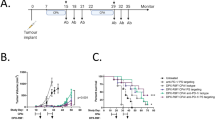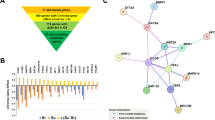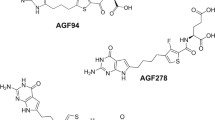Abstract
Parafibromin (PF) is a 531-amino acid protein encoded by HRPT2, a putative tumor suppressor gene recently implicated in the autosomal-dominant hyperparathyroidism-jaw tumor familial cancer syndrome and sporadic parathyroid carcinoma. To investigate effects of PF's overexpression on cell proliferation, we performed assays in four different cell lines. The transient overexpression of PF inhibited cell growth in HEK293 and NIH3T3 cells, but enhanced cell growth in the SV40 large T antigen-expressing cell lines such as 293FT and COS7 cells. In 293FT cells, PF was found to interact with SV40 large T antigen and its overexpression promoted entry into the S phase, implying that the interaction enhanced progression through the cell cycle. The tumor suppressor protein PF acts as a positive regulator of cell growth similar to an oncoprotein in the presence of SV40 large T antigen.
This is a preview of subscription content, access via your institution
Access options
Subscribe to this journal
Receive 50 print issues and online access
$259.00 per year
only $5.18 per issue
Buy this article
- Purchase on SpringerLink
- Instant access to full article PDF
Prices may be subject to local taxes which are calculated during checkout






Similar content being viewed by others
References
Ali SH, DeCaprio JA . (2001). Cellular transformation by SV40 large T antigen: interaction with host proteins. Semin Cancer Biol 11: 15–23.
Arnold A, Shattuck TM, Mallya SM, Krebs JJ, Costa J, Gallagher J et al. (2002). Molecular pathogenesis of primary hyperparathyroidism. J Bone Miner Res 17: N30–36.
Carpten JD, Robbins CM, Villablanca A, Forsberg L, Presciuttini S, Bailey-Wilson J et al. (2002). HRPT2, encoding parafibromin, is mutated in hyperparathyroidism-jaw tumor syndrome. Nat Genet 32: 676–680.
Chen S, Paucha E . (1990). Identification of a region of simian virus 40 large T antigen required for cell transformation. J Virol 54: 3350–3357.
Fanning E, Knippers R . (1992). Structure and function of simian virus 40 large tumor antigen. Annu Rev Biochem 61: 55–85.
Grimelius L, Johansson H . (1997). Pathology of parathyroid tumors. Semin Surg Oncol 13: 142–154.
Howell VM, Haven CJ, Kahnoski K, Khoo SK, Petillo D, Chen J et al. (2003). HRPT2 mutations are associated with malignancy in sporadic parathyroid tumours. J Med Genet 40: 657–663.
Jackson CE, Norum RA, Boyd SB, Talpos GB, Wilson SD, Taggart RT et al. (1990). Hereditary hyperparathyroidism and multiple ossifying jaw fibromas: a clinically and genetically distinct syndrome. Surgery 108: 1006–1013.
Kassem M, Zhang X, Brask S, Eriksen EF, Mosekilde L, Kruse TA . (1994). Familial isolated primary hyperparathyroidism. Clin Endocrinol Oxf 41: 415–420.
Kierstead TD, Tevethia MJ . (1993). Association of p53 binding and immortalization of primary C57BL/6 mouse embryo fibroblasts by using simian virus 40 T-antigen mutants bearing internal overlapping deletion mutations. J Virol 67: 1817–1829.
Marx S, Spiegel AM, Skarulis MC, Doppman JL, Collins FS, Liotta LA . (1998). Multiple endocrine neoplasia type 1: clinical and genetic topics. Ann Intern Med 129: 484–494.
Mizusawa N, Uchino S, Iwata T, Tsuyuguchi M, Suzuki Y, Mizukoshi T et al. (2006). Genetic analysis in patients with familial isolated hyperparathyroidism and hyperparathyroidism-jaw tumour syndrome. Clin Endoclinol (Oxf) 65: 9–16.
Moniaux N, Nemos C, Schmied BM, Chauhan SC, Deb S, Morikane K et al. (2006). The human homologue of the RNA polymerase II-associated factor1 (hPaf1) localized on the 19q13 amplicon, is associated with tumorigenesis. Oncogene 25: 3247–3257.
Mosimann C, Hausmann G, Basler K . (2006). Parafibromin/Hyrax activates Wnt/Wg target gene transcription by direct association with β-catenin/armadillo. Cell 125: 327–341.
Porter SE, Washburn TM, Chang M, Jaehning JA . (2002). The yeast paf1-RNA polymerase II complex is required for full expression of a subset of cell cycle-regulated genes. Eukaryot Cell 1: 830–842.
Rowland BD, Peeper DS . (2006). KLF4, p21 and context-dependent opposing forces in cancer. Nat Rev Cancer 6: 293–303.
Rozenblatt-Rosen O, Hughes CM, Nannepaga SJ, Shanmugam KS, Copeland TD, Guszczynski T et al. (2005). The parafibromin tumour suppressor protein is part of a human Paf1 complex. Mol Cell Biol 25: 612–620.
Schuffenecker I, Virally-Monod M, Brohet R, Goldgar D, Conte-Devolx B, Leclerc L et al. (1998). Risk and penetrance of primary hyperparathyroidism in multiple endocrine neoplasia type 2A families with mutations at codon 634 of the RET proto-oncogene. J Clin Endocrinol Metab 83: 487–491.
Shattuck TM, Valimak S, Obara T, Gaz RD, Clark OH, Shoback D et al. (2003). Somatic and germ-line mutations of HRPT2 gene in sporadic parathyroid carcinoma. N Engl J Med 349: 1722–1729.
Simmons DT . (2000). SV40 large T antigen functions in DNA replication and transformation. Adv Virus Res 55: 75–134.
Simonds WF, Robbins CM, Agarwal SK, Hendy GN, Carpten JD, Marx SJ . (2004). Familial isolated hyperparathyroidism is rarely caused by germline mutation in HRPT2, the gene for the hyperparathyroidism-jaw tumor syndrome. J Clin Endocrinol Metab 89: 96–102.
Szabo J, Heath B, Hill VM, Jackson CE, Zarbo RJ, Mallette LE et al. (1995). Hereditary hyperparathyroidism-jaw tumor syndrome: the endocrine tumor gene HRPT2 maps to chromosome 1q21-q31. Am J Hum Genet 56: 944–950.
Tan MH, Morrison C, Wang P, Yang X, Haven CJ, Zhang C et al. (2004). Loss of parafibromin immunoreactivity is a distinguishing feature of parathyroid carcinoma. Clin Cancer Res 10: 6629–6637.
Villablanca A, Calender A, Forsberg L, Hoog A, Cheng JD, Petillo D et al. (2004). Germline and de novo mutations in the HRPT2 tumour suppressor gene in familial isolated hyperparathyroidism. J Med Genet 41: e32.
Wassif WS, Farnebo F, Teh BT, Moniz CF, Li FY, Harrison JD et al. (1999). Genetic studies of a family with hereditary hyperparathyroidism-jaw tumour syndrome. Clin Endocrinol Oxf 50: 191–196.
Woodard GE, Lin L, Zhang JH, Agarwal SK, Marx SJ, Simonds WF . (2004). Parafibromin, product of the hyperparathyroidism-jaw tumor syndrome gene HRPT2, regulates cyclin D1/PRAD1 expression. Oncogene 24: 1272–1276.
Yart A, Gstaiger M, Wirbelauer C, Pecnik M, Anastasiou D, Hess D et al. (2005). The HRPT2 tumor suppressor gene product parafibromin associates with human Paf1 and RNA polymerase II. Mol Cell Biol 25: 5052–5060.
Yokoyama A, Somervaille TCP, Smith KS, Rosenblatt-Rosen O, Meyerson M, Cleary ML . (2005). The menin tumor suppressor protein is an essential oncogenic cofactor for MLL-associated leukemogenesis. Cell 123: 207–218.
Zhu B, Mandal SS, Pham AD, Zheng Y, Bromage HE, Batra SK et al. (2005). The human PAF complex coordinates transcription with events downstream of RNA synthesis. Gene Dev 19: 1668–1673.
Acknowledgements
We thank Dr BT Teh for anti-PF antibody. This work was supported in part by a grant-in-aid for scientific research from the Ministry of Education, Culture, Sports, Science and Technology of Japan.
Author information
Authors and Affiliations
Corresponding author
Rights and permissions
About this article
Cite this article
Iwata, T., Mizusawa, N., Taketani, Y. et al. Parafibromin tumor suppressor enhances cell growth in the cells expressing SV40 large T antigen. Oncogene 26, 6176–6183 (2007). https://doi.org/10.1038/sj.onc.1210445
Received:
Revised:
Accepted:
Published:
Issue date:
DOI: https://doi.org/10.1038/sj.onc.1210445
Keywords
This article is cited by
-
Co-sequencing and novel delayed anti-correlation identify function for pancreatic enriched microRNA biomarkers in a rat model of acute pancreatic injury
BMC Genomics (2018)
-
Crystal structure of the N-terminal domain of human CDC73 and its implications for the hyperparathyroidism-jaw tumor (HPT-JT) syndrome
Scientific Reports (2017)
-
CDC73 gene mutations in sporadic ossifying fibroma of the jaws
Diagnostic Pathology (2016)
-
The clinicopathological significances and biological functions of parafibromin expression in head and neck squamous cell carcinomas
Tumor Biology (2015)
-
Cytoplasmic parafibromin/hCdc73 targets and destabilizes p53 mRNA to control p53-mediated apoptosis
Nature Communications (2014)



